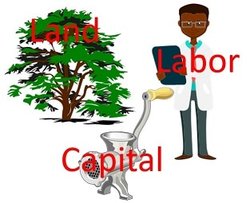Factor Market Supply and Demand
Updated 9/24/2021 Jacob Reed
Factor markets are an important part of any Microeconomics Principles class. If you are preparing for an Advanced Placement (AP), IB, or college exam, reviewing these markets is essential. Below is a quick examination of the important aspects of the demand for labor and marginal resource cost.

Note: The examples below use labor but these concepts apply to a firms use of capital and land as well.
Resource Payments: Depending on the resource in question, different terminology is used to define the payment. Workers are paid a wage (and most questions on exam generally deal with labor and wages paid). Land resources are paid for with rent. Capital resources are paid for with interest because businesses generally take out loans to purchase physical capital and the interest rate is a primary factor in determining how much physical capital is purchased (you will learn more about that in Macroeconomics). Economic rent is a term used to describe a payment above the minimum required to bring a resource into productive use. For example, if I require a minimum of $20 an hour to work on a Saturday (my opportunity cost or the value of my leisure time), any amount above $20 would be economic rent. If I were paid $25 an hour, I would be earning $5 economic rent per hour worked.
Derived Demand: The demand for resources is directly related to the demand for the products produced by those resources. As a result it is said that the demand for resources is a derived demand. That means if the demand for houses increases, the demand for construction workers will also increase. If the demand for corn increase, the demand for farmland to grow corn will increase. The reason for that derived demand comes from changes in product demand causing changes in a resource’s marginal revenue product.
Marginal Revenue Product (MRP): The demand for a resource is equal to the marginal revenue product of that resource. For firms in a perfectly competitive output market, marginal revenue product is equal to the price (Marginal Revenue) the product sells for times the marginal product (MR x MP). Essentially it is the money a firm brings in when they hire one more worker (the assumption here is the firm sells into a perfectly competitive product market). The most money a firm would ever be willing to pay to hire a worker is the marginal revenue product that worker produces. A firm would always (assuming they haven’t shut down) hire workers in the increasing returns stage of the MP curve. Also, a firm would never hire workers in the negative returns stage of the MP. As a result, a firm’s demand for labor is equal to a firm’s diminishing returns portion of the MRP curve (Yellow spots on the chart). See Chart B and the graph below as an example.
Note: Remember back to production functions that the marginal product curve is a flipped marginal cost curve. Since marginal revenue product comes from marginal product (times the price of the product), it will also be true that when marginal revenue product is decreasing, marginal cost is increasing (and vice versa).


Determinants of Labor Demand (Shifters): The demand curve in a labor market is derived from the demand for the product the workers produce and the productivity of the individual workers. If the demand for the product increases, demand for workers to make the product will increase. That is because increased demand for the product increases the price of the product and the increased price raises each worker’s marginal revenue product. Likewise, if the demand for the product decreases, there will be a decrease in the demand for the workers who make the product.
If anything increases productivity or MRP for workers, it increases the demand for those workers. If anything decreases the productivity or MRP of those workers, it decreases the demand for those workers. Education increases worker MRP and some occupations have higher worker MRP than others. As a result, there is higher demand for those workers and they tend to be paid higher wages as well.
Market Supply of Labor: The supply of labor within a market is determined by workers’ opportunity costs and willingness to work. As wages rise, more workers are willing to work. As wages fall, fewer workers are willing to work. As a result, a market labor supply curve is upward sloping. Anything that would change how many workers are willing to work aside from wages, will cause the labor supply curve to shift to the left (decrease) or right (increase).
Factor Market Equilibrium: Just like any other competitive market, price (wage in this case) and quantity will seek equilibrium. When wages are above equilibrium, there will be a surplus; wages will eventually fall and the surplus will be eliminated. When wages are below equilibrium, there will be a shortage; wages will eventually rise and the shortage will be eliminated. If the government were to impose an effective minimum wage (a price floor), the artificially high price, will cause some unemployment.
Note: minimum wage will not always cause unemployment as the wage could be below equilibrium (ineffective) or there could be some monopsony power with employers within a labor market.

Changes in Factor Market Equilibrium: Just like any other competitive market, changes in labor supply and labor demand will cause changes in equilibrium wage and equilibrium quantity of workers hired. What makes labor market analysis tricky is remembering that businesses are represented in the demand curve, and workers are represented in the supply curve.
Up Next:
Review Game: MRP/MRC Calculations
Content Review Page: Perfectly Competitive Factor Markets
